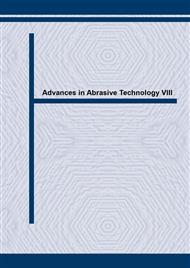p.413
p.419
p.425
p.433
p.439
p.443
p.447
p.453
p.459
High-Speed Milling Experiments on the Extended Length of Milling Tool
Abstract:
High speed milling is widely employed in die and mold machining, and the attentions had been gradually paid on the details during the process. Based on the high-speed milling experiments of hardened steel with different extended length of tool, cutting force, cutting vibration, tool wear and surface roughness were measured and analyzed in this paper. It was founded that cutting force and vibration were not increasing straightly with the addition of extended length, but fell down when exceeded a certain value, and the surface quality improved at same time.
Info:
Periodical:
Pages:
439-442
Citation:
Online since:
August 2005
Authors:
Keywords:
Price:
Сopyright:
© 2005 Trans Tech Publications Ltd. All Rights Reserved
Share:
Citation:


